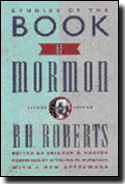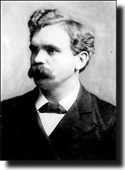
![]()

![]()
 A Mormon
General Authority's Doubts About the Authenticity of the Book of Mormon
A Mormon
General Authority's Doubts About the Authenticity of the Book of Mormon
Incredible as it may seem to many Latter-day Saints, Brigham H. Roberts (1857-1933), an LDS General Authority widely considered Mormonism's greatest apologist and historian,1 expressed the grave doubt that the Book of Mormon is a translation of ancient scripture. Elder Roberts reached this conclusion after his research uncovered extensive evidence that Joseph Smith borrowed the basic plot and many details from other books. This evidence — long suppressed because it is considered harmful to the Mormon Church — is presented in detail in three essays by Roberts, now published as Studies of the Book of Mormon (Salt Lake City: Signature Books, 1992).
More than fifty years after his death, Roberts is still well known through his many writings. They include the — Introduction and Notes — to Joseph Smith's seven volume History of the Church, the six volume A Comprehensive History of the Church of Jesus Christ of Latter-day Saints, Outlines of Ecclesiastical History, and New Witnesses for God (3 vols). However, in 1922 Roberts became aware of troubling evidence that Joseph Smith borrowed much of the plot and other details of the Book of Mormon from other books readily available to him,2 in particular Josiah Priest's Wonders of Nature and Providence, and Ethan Smith's View of the Hebrews. For instance, it is often thought the Book of Mormon claim that the American Indians are descendents of Hebrew immigrants is a novel idea that young Joseph Smith could not have invented. But Roberts discovered from Priest's book, published in 1824, six years before the first edition of the Book of Mormon (1830), that it was the almost universal opinion of the ministers of New England and the Middle States, that the Indians were the descendants of the Hebrews (Studies, p. 153).
In Ethan Smith's View of the Hebrews, first published in 1823, seven years before the Book of Mormon (and in a second edition in 1825), Roberts discovered a virtual ground plan for the Book of Mormon. In section two of Studies of the Book of Mormon, entitled, "A Book of Mormon Study," Roberts takes nearly 100 pages to describe the specific parallels between Ethan Smith's, View of the Hebrews and the Book of Mormon.
Did Ethan Smith's View of the Hebrews furnish structural material for Joseph Smith's Book of Mormon? Roberts was forced to admit that the evidence pointed in this direction:
It has been pointed out in these pages that there are many things in the former book that might well have suggested many major things in the other. Not a few things merely, one or two, or half dozen, but many; and it is this fact of many things of similarity and the cumulative force of them that makes them so serious a menace to Joseph Smith's story of the Book of Mormon's origin ... The material in Ethan Smith's book is of a character and quantity to make a ground plan for the Book of Mormon (Studies, p. 240).
Having established that Joseph Smith had plenty of material from which to get his ideas for the Book of Mormon, Roberts moves to a second key question: Did the young Joseph Smith have enough naturally creative ability to weave together a narrative like the Book of Mormon:
... was Joseph Smith possessed of a sufficiently vivid and creative imagination as to produce such a work as the Book of Mormon from such materials as have been indicated in the preceding chapters ...? That such power of imagination would have to be of a high order is conceded; that Joseph Smith possessed such a gift of mind there can be no question (Studies, p. 243).
 One
of the things that convinced Roberts of this is the testimony of Joseph's
mother, Lucy Mack Smith. She wrote the following about her son's creative
abilities:
One
of the things that convinced Roberts of this is the testimony of Joseph's
mother, Lucy Mack Smith. She wrote the following about her son's creative
abilities:
During our evening conversations, Joseph would occasionally give us some of the most amusing recitals that could be imagined. He would describe the ancient inhabitants of this continent, their dress, mode of travelings, and the animals upon which they rode; their cities, their buildings, with every particular; their mode of warfare; and also their religious worship. This he would do with as much ease, seemingly, as if he had spent his whole life among them (Studies, p. 243).
From this testimony it is apparent that Joseph was known by his own family as quite a storyteller. And the significance of this evening storytelling, Roberts points out, is that Joseph was doing all this before he had supposedly received the gold plates from the angel Moroni (Studies, p. 244).
Based on this evidence, Roberts draws the following conclusion:
These evening recitals could come from no other source than the vivid, constructive imagination of Joseph Smith, a remarkable power which attended him through all his life. It was as strong and varied as Shakespeare's and no more to be accounted for than the English Bard's (Studies, p. 244).
Statements like these help us understand why LDS church leaders did not want the B. H. Roberts material in circulation. And even today, many people are still unaware of the evidence compiled by this well-known Mormon apologist and historian. Fortunately, this fascinating research is now easily accesible to any who want a fuller understanding of the true origins of the Book of Mormon.
Joel B. Groat
Notes
- Roberts was ranked the greatest intellectual in Mormon history in surveys by LDS scholars Leonard Arrington in 1969 and Stan Larson in 1993 — see Leonard J. Arrington, "The Intellectual Tradition of the Latter-day Saints," Dialogue: A Journal of Mormon Thought 4 (Spring 1969), pp. 13-26 and Stan Larson, "Intellectuals in Mormonism: An Update," Dialogue: A Journal of Mormon Thought 26 (Fall 1993), pp. 187-89.
- Josiah Priest's Wonders of Nature and Providence was published in New York state, only about twenty miles from where the Smith family resided from about 1815 to 1830, and Ethan Smith's View of the Hebrews was published in Poultney, Vermont, only a few miles from Windsor, Vermont where Joseph Smith's family lived until he was ten years of age. Roberts considered it "probable" that Ethan Smith's book was "either possessed by Joseph Smith or certainly known by him, for [it] was surely available to him" — Studies of the Book of Mormon, p. 153.
Etusivu > Kirjallisuus | Sivun alkuun